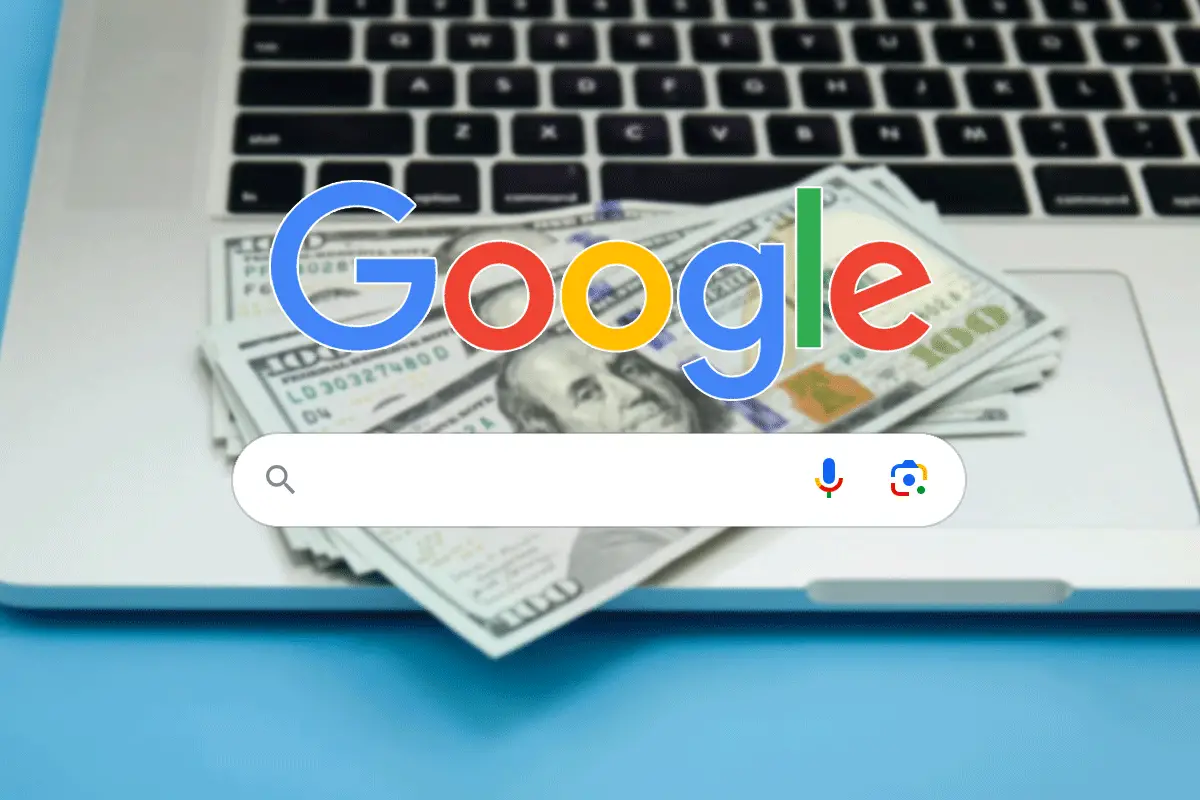Purchasing keywords on Google is a guaranteed way to rank your website at the top of the search engine results pages (SERPs) for the words and phrases that matter most to your business.
In this guide, you’ll learn how to buy keywords on Google the right way to improve your search engine marketing results. The first part includes step-by-step instructions on setting up paid advertising campaigns that target specific keywords with Google Ads. The second part shows you how to use Google Keyword Planner to conduct keyword research to help pick the best words and phrases for your ad campaigns.
How to Buy Keywords On Google
1. Sign Up for Google Ads
The first step for how to buy keywords on Google is to go to ads.google.com and sign up for the Google Ads platform, which requires a verified Google account. If you already have a Gmail account, then you can quickly gain access to Google Ads.
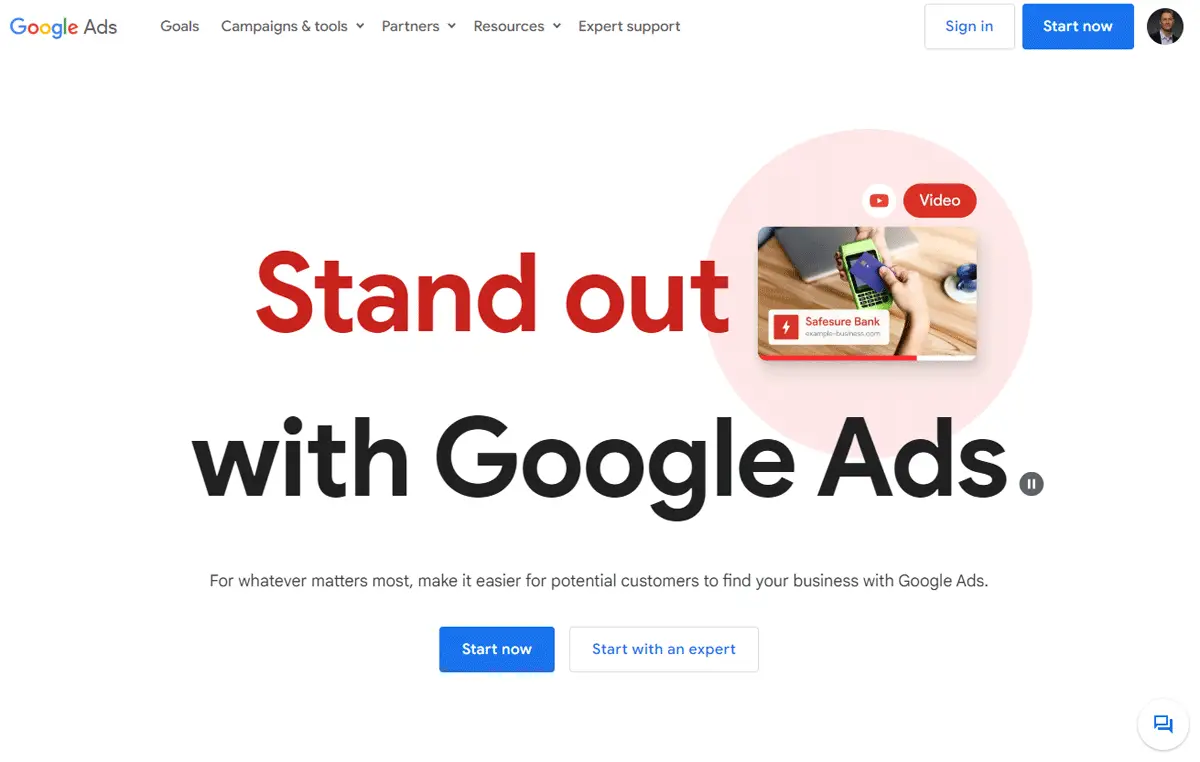
2. Create a Keyword Ad Campaign
The next step for how to purchase keywords on Google is to create a new keyword ad campaign. Campaigns in Google Ads are a set of ad groups that contain your various ads, keywords, and bids that share the same budget, location targeting, and other settings.
You can have multiple ad campaigns running at once that allow you to organize your ads and keyword sets based on specific categories.
When you start an ad campaign, you have to choose an objective that targets a certain goal, such as:
- Sales
- Leads
- Website Traffic
- Product and Brand Consideration
- Brand Awareness
- App Promotion
- Local Store Visits and Promotions
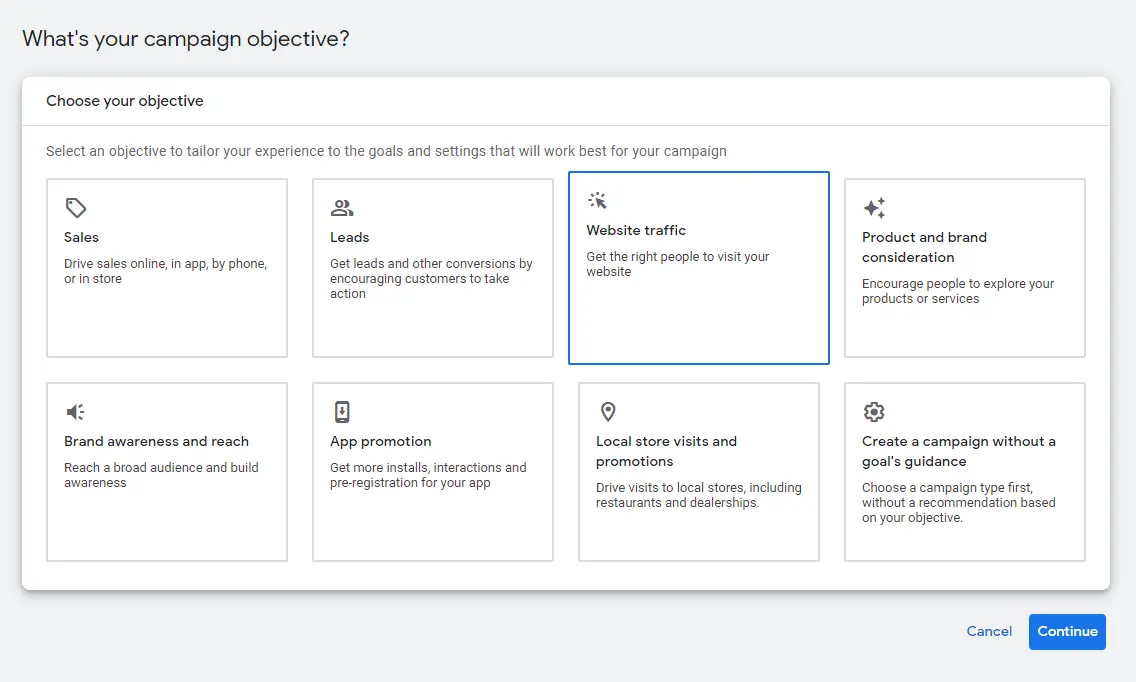
After you’ve chosen an objective, you’ll then need to select a campaign type. You can buy keywords on Google and have your ads appear in Google Search, the Display Network, Discover Network, Shopping pages, YouTube, Gmail, etc.
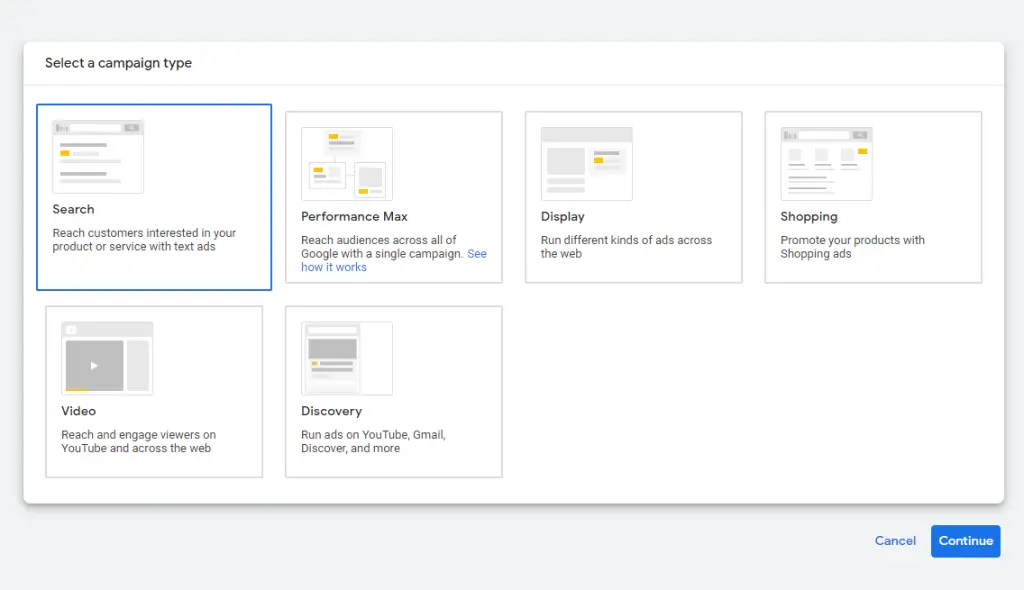
For the purposes of this guide, you’ll want to choose the Search campaign type so you can reach people on Google’s search engine through purchased text ads based on targeted SEO keywords.
Once you’re done with the initial Google Ads campaign setup, you’ll be able to give your campaign a name so you can save these settings and move on to step 3.
3. Set Your Keyword Bid
The next step for buying keywords on Google is to choose your keyword bid. This is done under the “Bidding” section.
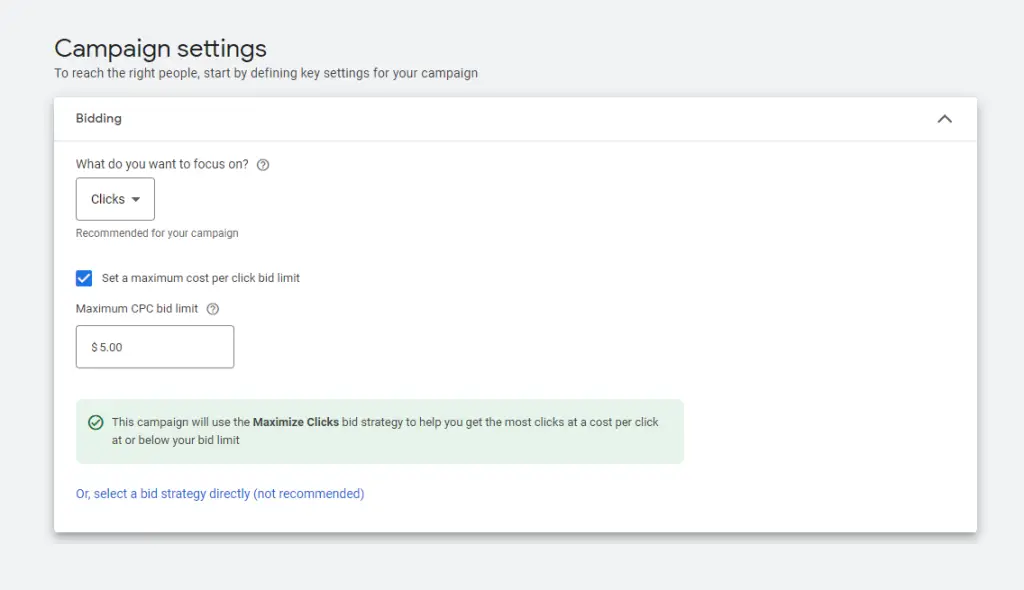
Here, you’ll want to use these campaign settings:
- Clicks for the focus type.
- Set a maximum cost per click bid limit box is checked.
- Maximum CPC bid limit set to a price you are willing to buy ads on Google per click.
Using this ad campaign bidding strategy helps you get the most clicks for a Cost-Per-Click (CPC) value that’s at or below your maximum bid limit.
4. Select Locations and Languages
Next, you need to choose a target location for your keyword ads to appear. You can select all countries and locations to reach people everywhere in the world with your ad campaign or narrow your keyword purchasing on Google to specific places for hyper-focused targeting.
Google Ads also lets you select the languages your customers speak if this is important for your keyword targeting. This option is helpful for maximizing your purchasing power of keywords on Google so you don’t pay for clicks by people who don’t speak a certain language in your target location.
5. Choose an Audience Segment
Choosing an audience segment is one of the most important areas to optimize Google Ads to target the right users with your ads. Otherwise, you may end up buying keywords and getting clicks from people who have no direct interest in your website, products, or services.
Select audience segments that best match your ad campaign. You can narrow down your target audience by demographics, interests, hobbies, search history, etc.
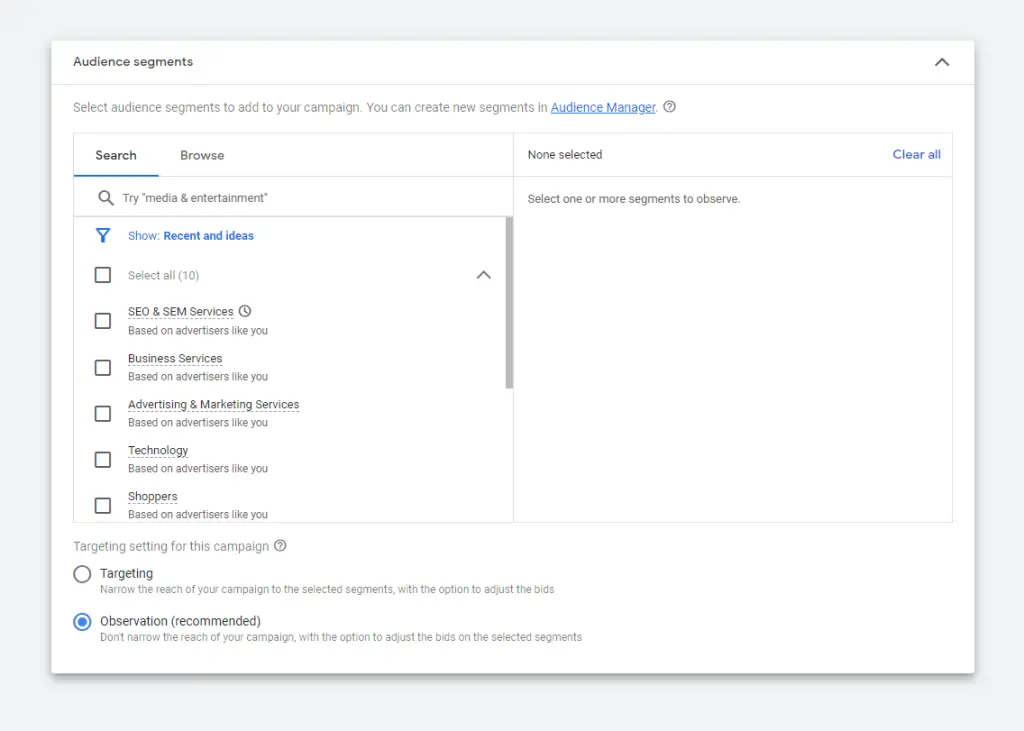
6. Choose the Keywords to Buy
At this point in the process, you’ll start working on your first Ad Group. This step requires you to choose the keywords you want to buy on Google for your website, products, and services.
If you already know what keywords you want to purchase, then you can add words and phrases to the Enter keywords box so they’ll be used to match your ads with the terms people are searching for online.
If you need keyword suggestions, Google can help with that too. Just add the target web page URL into the appropriate field and then click the “Get Keywords” button. Google will then crawl the page and automatically suggest keywords you should target on its search engine.
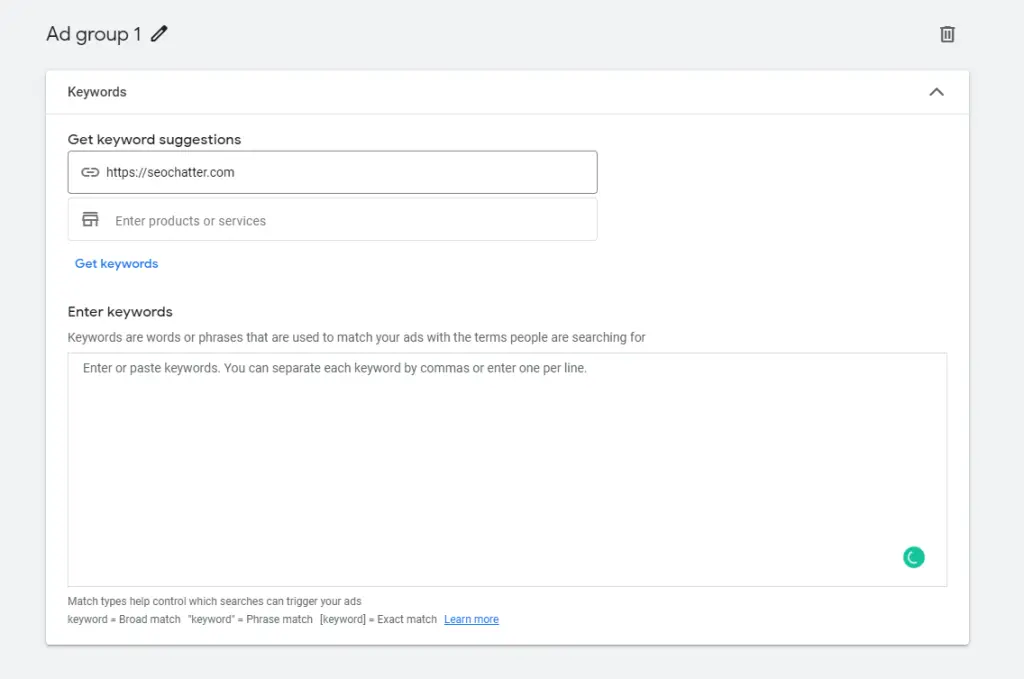
You can further refine your keyword list by modifying the words and phrases based on the match types below:
- Broad Match: This is the default match type without any word modifiers attached. Broad match lets a keyword trigger your ad whenever someone searches for that phrase, similar phrases, singular forms, plural forms, synonyms, misspellings, relevant variations & other related searches.
- Phrase Match: This match type requires you to add quotes around the keyword, such as “used books”. Phrase match keywords allow your ad to trigger when users search for an exact phrase or the phrase has terms added before or after it, such as “buy used books” or “used books for sale”.
- Exact Match: This match type requires you to add brackets around the keyword, such as [men’s running shoes]. Exact match keywords are the most targeted matching without any loose connections to user searches. Your ad will only appear if the user types in the exact phrase into the search engine.
Pro Tip: You should not use more than 20 keywords per ad group in Google Ads. This keyword limit helps you get the maximum value from your ad budget when purchasing keywords while also targeting the right audience for each ad group in the campaign. See this related guide for more details: How Many Keywords Per Ad Group.
7. Create Your Ad
The next step to follow after deciding on your target SEO keywords is to create the ad. Here, you’ll need to come up with a good headline, descriptive ad text, and include a target URL for users to click on.
The ultimate goal when creating your ad is to increase the Quality Score (QS) which is how Google’s Ads system determines the position your ad should rank in the search engine results pages (SERPs).
As Google states in this guide on improving your Quality Score, there are five things you can do:
- Make ads more relevant to your chosen keywords.
- Edit the ad text to increase click-through rates (CTR).
- Ensure the content on the landing page matches the keywords you’re targeting for SEO.
- Remove low-performing keywords from your ads.
The better your ad’s Quality Score, the higher your ad ranks in Google’s search results for your target keywords. If your QS is low, then you’ll have fewer people seeing your ad and fewer users visiting your website. Google will give you the Quality Score for your paid ads, but it’s up to you to make adjustments to the key areas listed above to improve the QS for higher rankings on Google Search.
8. Set Your Average Daily Budget
When you’re purchasing keywords on Google you need to set an average daily budget so you can put a cap on how much you’re going to pay per day for keyword ad clicks. Otherwise, Google would keep charging your Ads account no matter how much it costs; putting you over budget.
Google’s Ads system is set up like this to make sure you don’t spend more than you intend on keyword targeting:
- Throughout the month, you will never pay more than your daily budget multiplied by the average number of days in a month.
- Some days you may spend less than your daily budget, and on other days you could spend up to twice as much.
- Overall, Google will make sure you’re not spending any more than your average budget assigned to the campaign.
9. Publish Your Campaign
At this stage of the process, you’re ready to publish your campaign. On this screen, you can review and double-check the details before you publish the keyword-optimized ad set. Google will then review the ad for compliance and turn it on so it appears in the search engine for your target audience to see.
10. Purchase More Keywords On Google
The final step to buying keywords on Google is to purchase more search terms on the platform by creating additional ad groups under the same campaign or by setting up new campaigns entirely.
If you’re serious about buying SEO keywords for higher rankings on Google, then you should repeat the steps above to create more ad groups or campaigns so you can test which keyword sets deliver the highest return on investment (ROI) for your digital marketing budget.
There are multiple variables you can test with each ad in Google Ads, such as the words and phrases you’re targeting, the ad headline, the ad display text, the content on the landing page URL, etc. You can also test the targeting demographics to find out which type of person or location delivers the highest ROI for your keyword ad budget.
Essentially, you want to continue to refine and iterate your ad targeting month after month so you can achieve the best results for your website and business goals.
You Can Research Keywords Before You Purchase Them with Google Keyword Planner
Another tool Google gives you for choosing the right keywords for paid SEO search campaigns before you start an ad campaign is Google Keyword Planner. Keyword Planner is a free tool that helps you discover relevant words and phrases for your website, products, and services along with estimates of the cost-per-click and search volume they receive.
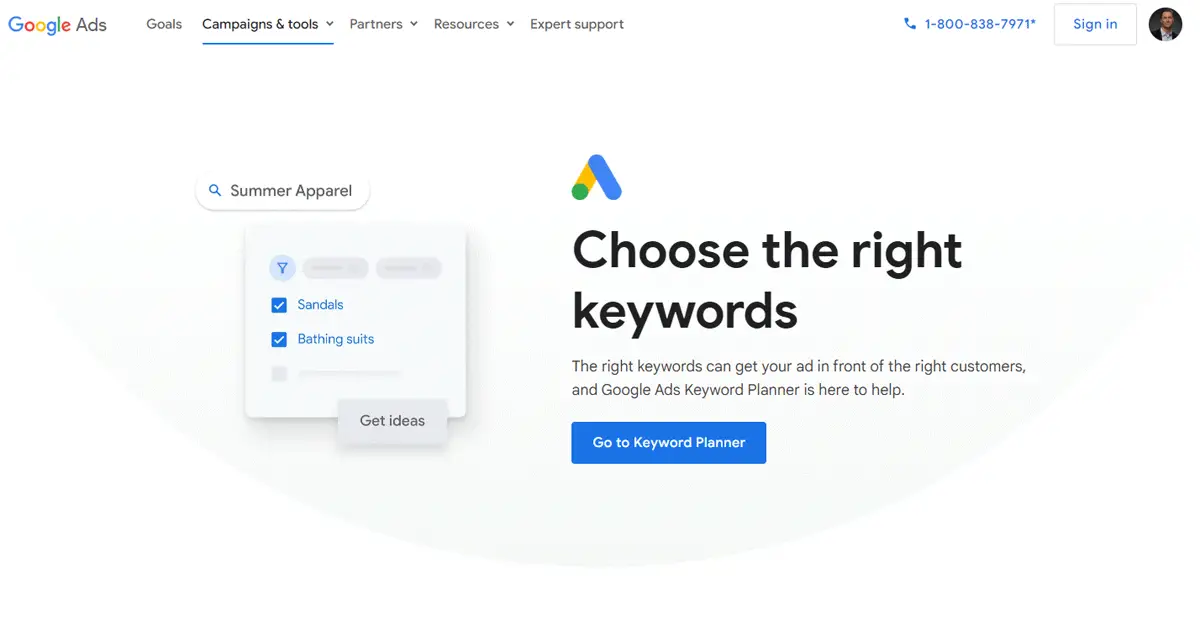
Keyword Planner is a great tool for doing in-depth keyword research to create better-optimized ad campaigns before you buy keywords on Google Ads. You can also build stronger keyword lists in the software and transfer them over to Google Ads to set up new paid search campaigns after you’ve completed the keyword research process.
You can access Google Keyword Planner in two ways:
- Sign in directly at ads.google.com/home/tools/keyword-planner/.
- Inside the Google Ads platform, click on Tools and Settings > Keyword Planner.
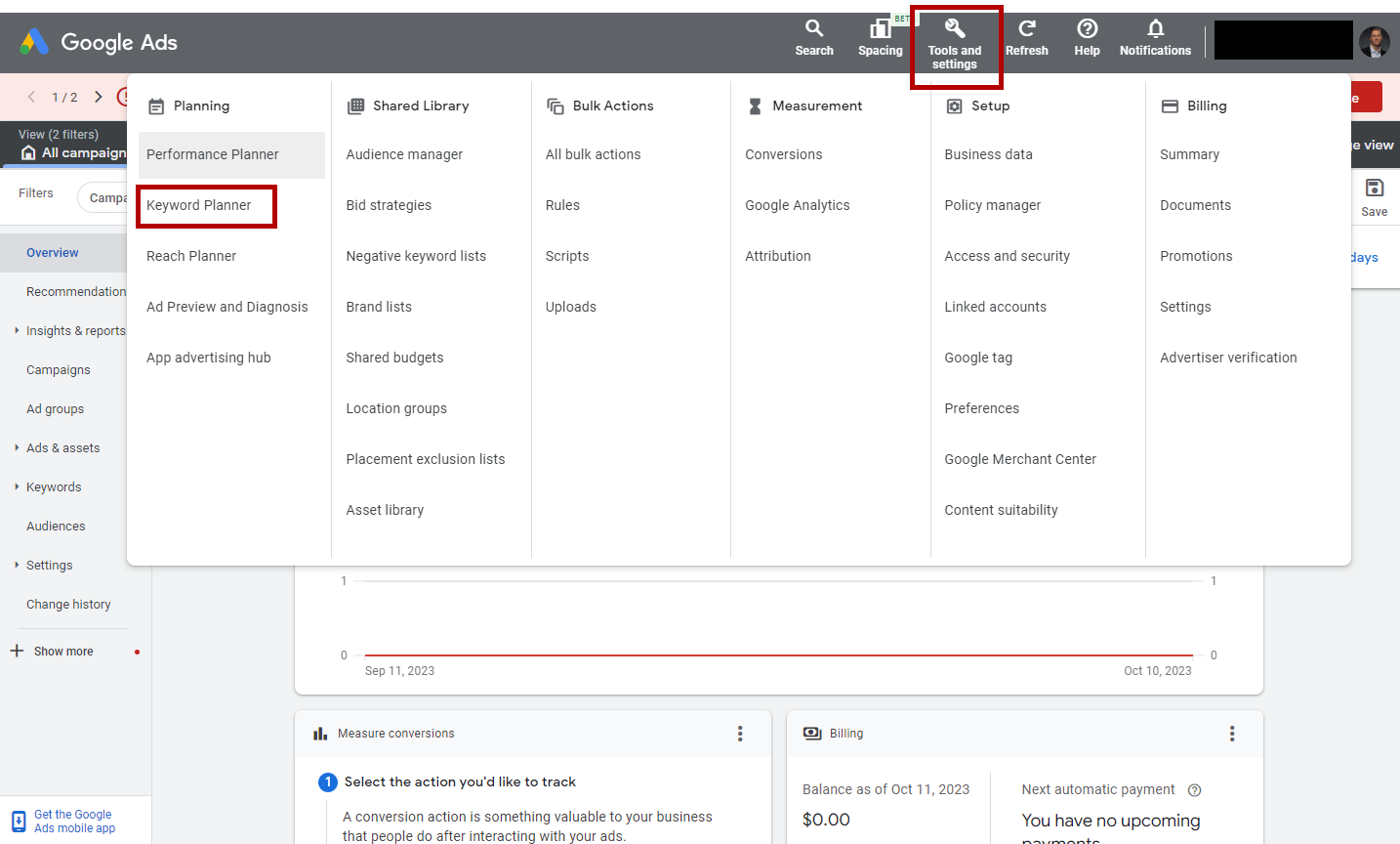
The Keyword Planner tool gives you three options to find and organize keywords for your paid ad campaigns:
- Discover new keywords: Get keyword ideas that can help you reach people interested in your product or service.
- Get search volume and forecasts: Get search volume and other historical metrics, plus forecasts for how they could perform.
- Organize keywords into ad groups: Save time by automatically organizing keywords into ad groups in your account.
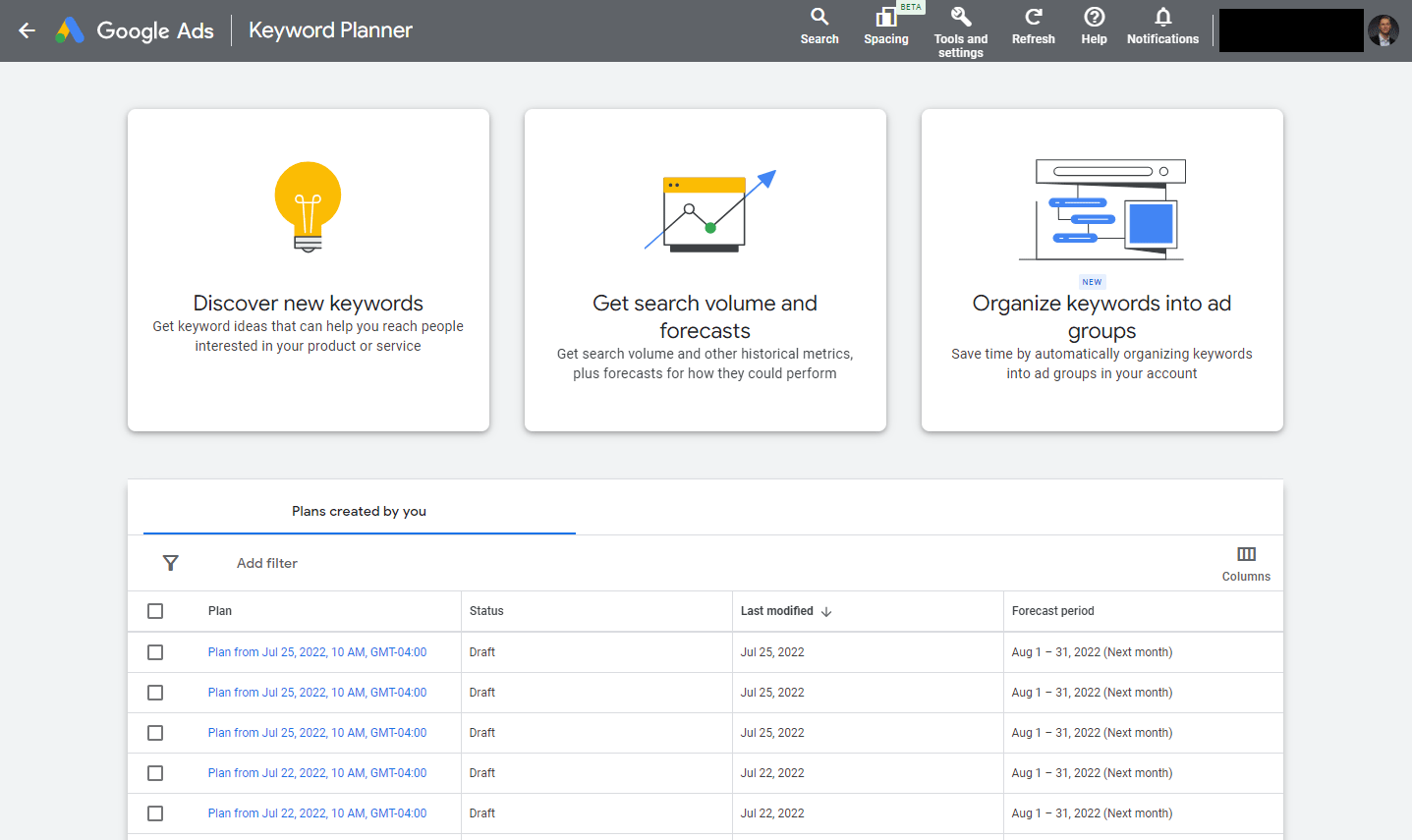
Here’s a screenshot of the output in Keyword Planner after searching for the phrase “Google ad management services”. As you can see, Keyword Planner has suggested more than 100 relevant keywords to consider for a paid Google Ads campaign.
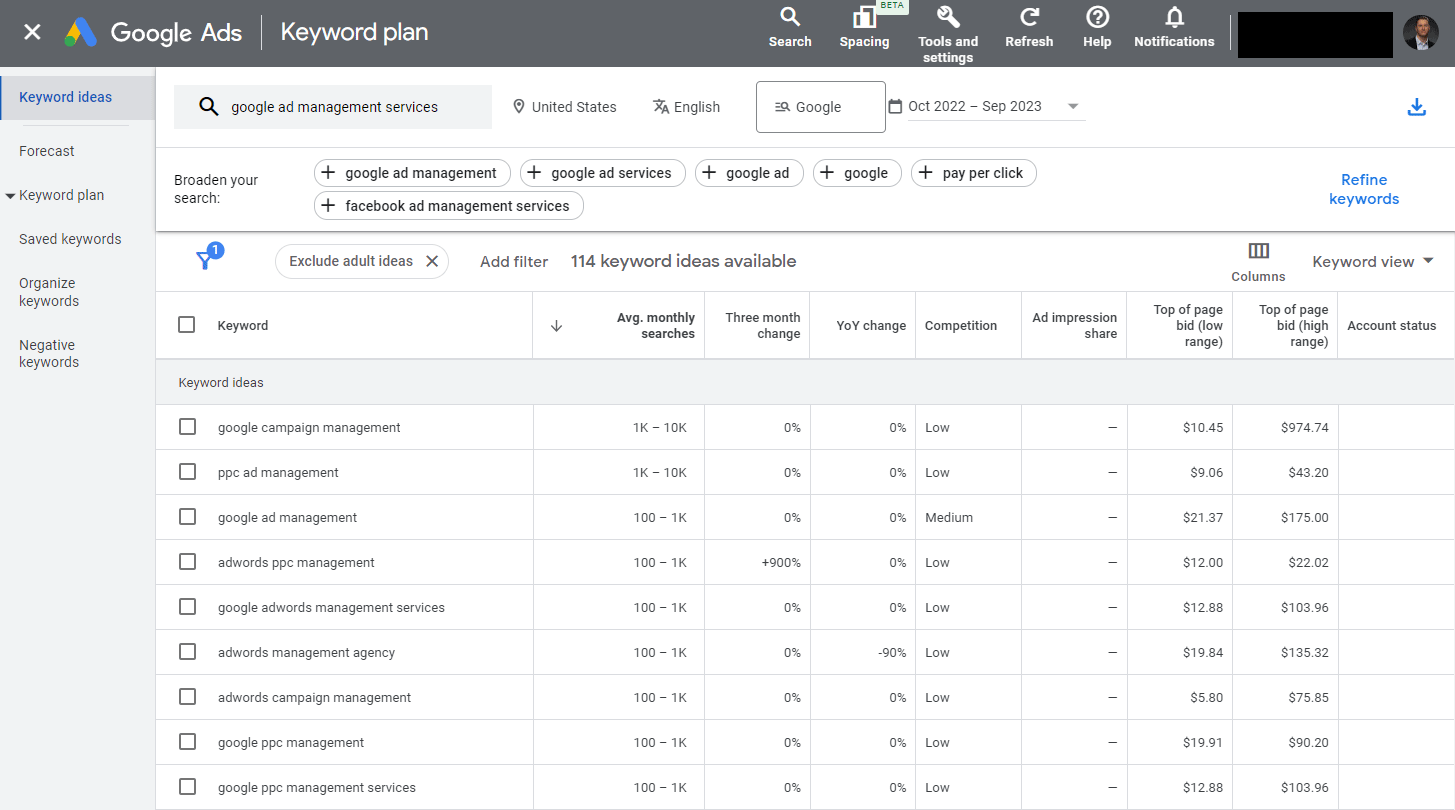
Keyword Planner also gives you the following information to make a data-driven choice on which keywords to purchase and use in your Google Ads:
- Average monthly search volume
- Three month change in search trend
- Year over Year change in search volume
- Competition level for advertisers
- Ad impression share
- Top of page bid (low range)
- Top of page bid (high range)
- Account status showing if the keyword is added to your plan
Frequently Asked Questions and Answers
How Much Does It Cost to Buy Keywords On Google?
The cost of buying keywords on Google can vary from 50 cents to $50 per click or more. Keyword price is based on a cost-per-click (CPC) value that depends on the competition level and the industry.
The average CPC on the Google Display Network is under $1 while the average CPC on the Google Search Network is between $1 and $2 for most keywords and industries.
Why Are Some Keywords So Expensive?
Some keywords are expensive because of the high demand among advertisers who want to pay for keyword-optimized ads. Keywords that are in high demand become more costly to purchase due to advertisers driving up the price of each click through competition.
The most expensive keywords on Google are generally competitive terms in industries that have high customer lifetime values (LTV), like law, healthcare, and insurance. Keywords with higher search volumes also tend to have the most expensive prices.
Why Should I Purchase Keywords On Google?
Purchasing keywords on Google works faster than SEO to build a larger audience for your website or brand. Buying keywords with Google Ads is also measurable and flexible so you can target the right keywords to attract the best audience based on your business goals.
When you purchase keywords through Google Ads, you only pay for the clicks that your ads receive instead of impressions. This pay-per-click (PPC) advertising model allows you to save money and maximize your budget by only paying a cost when a user has taken action to view your website. (See this related guide on the difference between SEO and PPC for more details about how these digital marketing strategies compare.)
You also get detailed performance tracking with Google Ads so you can measure the number of users who view and click on your ads for each keyword you’re bidding on. This is good information to know because you can further optimize your ads to increase the click-through rates (CTR) and/or decide if an SEO keyword is worth targeting or not based on the sales and conversions you’re getting on the landing page.
According to Google’s Economic Impact report, businesses can make an average of $2 for every dollar spent buying keywords on Google. That’s really the best metric to measure for success in advertising performance. The fact is that your return on investment for purchasing a keyword is more important than the number of clicks the ad receives.
Summary for Buying Keywords On Google
I hope you enjoyed this guide on how to buy keywords on Google.
As you discovered, the process for how to purchase keywords on Google is easy to do and only requires you to have a Google Ads account. Once that’s set up, you can bid on any keyword you’d like to have your website show up on in Google’s search results. This paid advertising strategy works faster than SEO and can allow you to get the top-ranking spots on Google if you have high-quality ads and a large enough marketing budget.

SEO Chatter is dedicated to teaching the fundamentals of search engine marketing to help marketers understand how to increase organic website traffic and improve search engine rankings.

